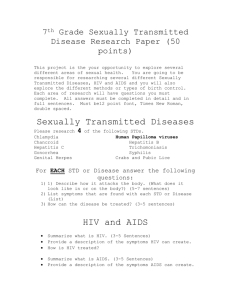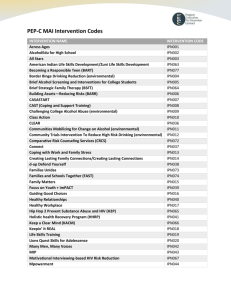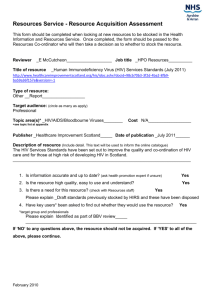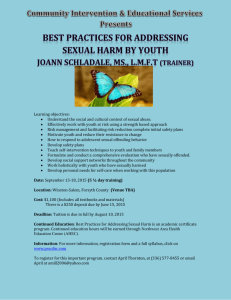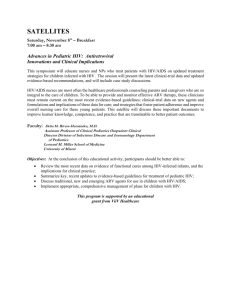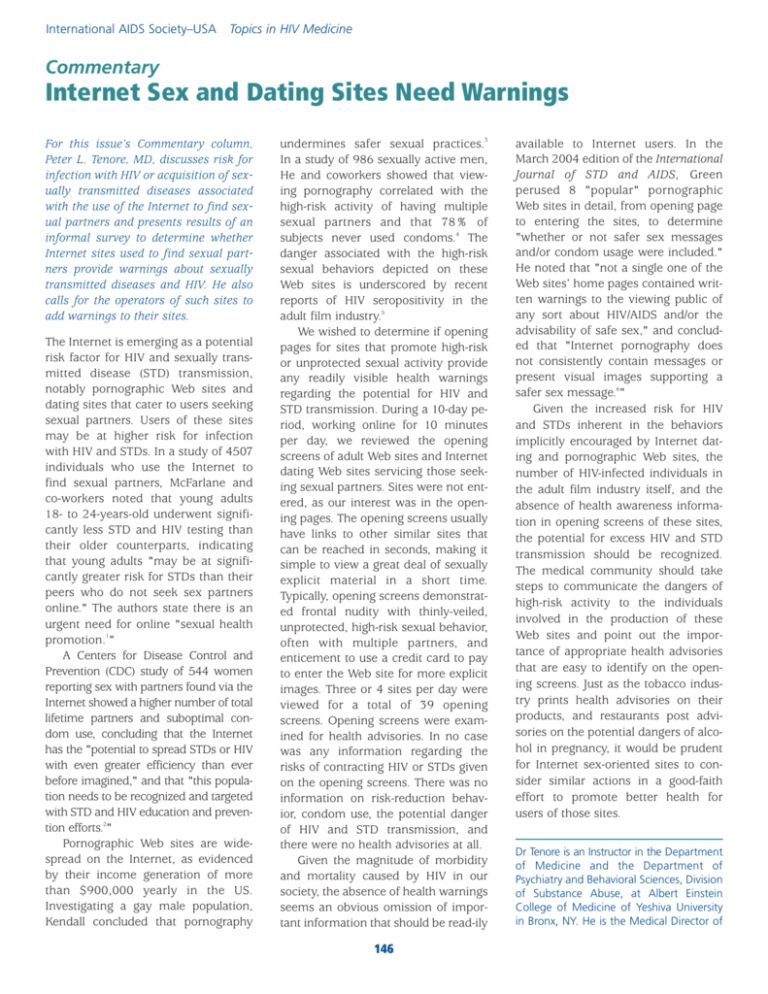
International AIDS Society–USA
Topics in HIV Medicine
Commentary
Internet Sex and Dating Sites Need Warnings
For this issue’s Commentary column,
Peter L. Tenore, MD, discusses risk for
infection with HIV or acquisition of sexually transmitted diseases associated
with the use of the Internet to find sexual partners and presents results of an
informal survey to determine whether
Internet sites used to find sexual partners provide warnings about sexually
transmitted diseases and HIV. He also
calls for the operators of such sites to
add warnings to their sites.
The Internet is emerging as a potential
risk factor for HIV and sexually transmitted disease (STD) transmission,
notably pornographic Web sites and
dating sites that cater to users seeking
sexual partners. Users of these sites
may be at higher risk for infection
with HIV and STDs. In a study of 4507
individuals who use the Internet to
find sexual partners, McFarlane and
co-workers noted that young adults
18- to 24-years-old underwent significantly less STD and HIV testing than
their older counterparts, indicating
that young adults "may be at significantly greater risk for STDs than their
peers who do not seek sex partners
online." The authors state there is an
urgent need for online "sexual health
promotion.1"
A Centers for Disease Control and
Prevention (CDC) study of 544 women
reporting sex with partners found via the
Internet showed a higher number of total
lifetime partners and suboptimal condom use, concluding that the Internet
has the "potential to spread STDs or HIV
with even greater efficiency than ever
before imagined," and that "this population needs to be recognized and targeted
with STD and HIV education and prevention efforts.2"
Pornographic Web sites are widespread on the Internet, as evidenced
by their income generation of more
than $900,000 yearly in the US.
Investigating a gay male population,
Kendall concluded that pornography
undermines safer sexual practices.3
In a study of 986 sexually active men,
He and coworkers showed that viewing pornography correlated with the
high-risk activity of having multiple
sexual partners and that 78% of
subjects never used condoms.4 The
danger associated with the high-risk
sexual behaviors depicted on these
Web sites is underscored by recent
reports of HIV seropositivity in the
adult film industry.5
We wished to determine if opening
pages for sites that promote high-risk
or unprotected sexual activity provide
any readily visible health warnings
regarding the potential for HIV and
STD transmission. During a 10-day period, working online for 10 minutes
per day, we reviewed the opening
screens of adult Web sites and Internet
dating Web sites servicing those seeking sexual partners. Sites were not entered, as our interest was in the opening pages. The opening screens usually
have links to other similar sites that
can be reached in seconds, making it
simple to view a great deal of sexually
explicit material in a short time.
Typically, opening screens demonstrated frontal nudity with thinly-veiled,
unprotected, high-risk sexual behavior,
often with multiple partners, and
enticement to use a credit card to pay
to enter the Web site for more explicit
images. Three or 4 sites per day were
viewed for a total of 39 opening
screens. Opening screens were examined for health advisories. In no case
was any information regarding the
risks of contracting HIV or STDs given
on the opening screens. There was no
information on risk-reduction behavior, condom use, the potential danger
of HIV and STD transmission, and
there were no health advisories at all.
Given the magnitude of morbidity
and mortality caused by HIV in our
society, the absence of health warnings
seems an obvious omission of important information that should be read-ily
146
available to Internet users. In the
March 2004 edition of the International
Journal of STD and AIDS, Green
perused 8 "popular" pornographic
Web sites in detail, from opening page
to entering the sites, to determine
"whether or not safer sex messages
and/or condom usage were included."
He noted that "not a single one of the
Web sites’ home pages contained written warnings to the viewing public of
any sort about HIV/AIDS and/or the
advisability of safe sex," and concluded that "Internet pornography does
not consistently contain messages or
present visual images supporting a
safer sex message.6"
Given the increased risk for HIV
and STDs inherent in the behaviors
implicitly encouraged by Internet dating and pornographic Web sites, the
number of HIV-infected individuals in
the adult film industry itself, and the
absence of health awareness information in opening screens of these sites,
the potential for excess HIV and STD
transmission should be recognized.
The medical community should take
steps to communicate the dangers of
high-risk activity to the individuals
involved in the production of these
Web sites and point out the importance of appropriate health advisories
that are easy to identify on the opening screens. Just as the tobacco industry prints health advisories on their
products, and restaurants post advisories on the potential dangers of alcohol in pregnancy, it would be prudent
for Internet sex-oriented sites to consider similar actions in a good-faith
effort to promote better health for
users of those sites.
Dr Tenore is an Instructor in the Department
of Medicine and the Department of
Psychiatry and Behavioral Sciences, Division
of Substance Abuse, at Albert Einstein
College of Medicine of Yeshiva University
in Bronx, NY. He is the Medical Director of
Commentary – Internet Sex and Dating Sites Need Warnings
the Trailer I Clinic, which is part of the
Substance Abuse division’s addiction
pharmacotherapy and behavioral health
care facilities.
The Albert Einstein College of Medicine
of Yeshiva University methadone clinics
provide substance abuse care to some
3500 opiate-dependent patients in 10
clinics in Bronx, NY. Full services for HIVinfected individuals, including medical care,
substance abuse treatment with methadone and other modalities, and psychiatric
services are provided. HIV and STD transmission information and the need for
risk-reduction are consistently reinforced by
specific caseworkers dedicated to this topic.
Volume 14 Issue 4 October/November 2006
References
1. McFarlane M, Bull SS, Rietmeijer CA. Young
adults on the Internet: risk behaviors for sexually transmitted diseases and HIV(1). J Adolesc
Health. 2002;31:11-16.
2. McFarlane M, Kachur R, Bull S, Rietmeijer C.
Women, the Internet, and sexually transmitted
infections. J Womens Health. 2004;13:689-694.
5. Centers for Disease Control and Prevention.
HIV transmission in the adult film industry – Los
Angeles, California, 2004. MMWR Morb Mortal
Wkly Rep. 2005;54:923-926.
6. Green ST. HIV and AIDS, the internet pornography industry and safer sex. Int J STD AIDS.
2004;15:206-208.
3. Kendall CN. Educating gay male youth: since
when is pornography a path towards selfrespect? J Homosex. 2004;47:83-128.
4. He N, Detels R, Chen Z, et al. Sexual behavior
among employed male rural migrants in Shanghai,
China. AIDS Educ Prev. 2006;18:176-186.
147
Top HIV Med. 2006;14(4):146-147
Copyright 2006, International AIDS Society–USA

